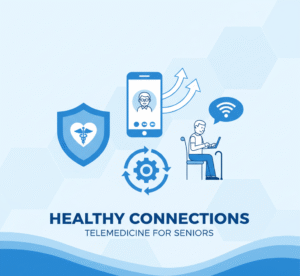“Harness the power of online reviews and referrals to grow your medical practice. Learn practical strategies for patient acquisition, healthcare reputation management, and increasing patient trust to expand your reach.”
In today’s interconnected world, a healthcare practice thrives on the quality of its medical care and public perception. For healthcare providers, building trust and enhancing reputation are paramount. In this digital age, two powerful forces stand out in achieving these goals: online reviews and patient referrals. These aren’t just buzzwords but essential patient acquisition strategies that can significantly impact your practice’s growth and stability.
Think about it: when someone needs a new doctor, what’s one of the first things they do? They often turn to the internet. They search. They read. They look for validation from others who have walked a similar path. That’s where patient testimonial marketing comes into play, even if it’s not explicitly called that by patients. These online conversations, whether positive or negative, shape potential patients’ decisions long before they even step foot in your clinic. Similarly, a personal recommendation from a trusted friend or family member carries immense weight. This traditional yet enduring form of medical referral marketing remains incredibly effective.
This article will show how healthcare providers can effectively harness online reviews and patient referrals. We’ll explore practical strategies for encouraging patient feedback, managing your online reputation, and creating robust referral programs. We’ll offer real-world insights and actionable steps to help your practice survive and flourish in a competitive healthcare landscape. You’ll learn how to increase patient trust and ensure your digital footprint accurately reflects the high-quality care you provide.
The Power of Online Reviews in Healthcare
Online reviews are more than just stars and comments on a website. They are digital word-of-mouth. They are the collective voice of your patients, sharing their experiences with the world. For a prospective patient, reading about another’s positive experience with a doctor can help decide when scheduling an appointment. Conversely, a string of negative reviews can deter them instantly. This makes effective healthcare reputation management not just important, but critical.
Consider a recent study: a significant percentage of patients use online reviews as their first step in finding a new healthcare provider. They trust these peer-generated insights almost as much as if not more than, a personal recommendation. This trend highlights a fundamental shift in how patients choose their medical care. Your doctor’s online reputation is now a tangible asset, directly linked to patient volume and practice revenue.
Every review, good or bad, offers a window into your practice. Positive reviews highlight your strengths: compassionate staff, short wait times, effective treatments, and clear communication. They serve as compelling endorsements. Negative reviews, while challenging, provide invaluable feedback. They pinpoint areas for improvement, allowing you to address issues and refine your services. Ignoring them is not an option. Instead, they present an opportunity for growth and demonstrate your commitment to patient satisfaction.
Crafting Your Patient Review Strategy: Encouraging Feedback
So, how do you get more of those positive reviews? It requires a proactive and thoughtful patient review strategy. You can’t just hope for them; you must create an environment where patients feel encouraged and empowered to share their experiences.
First, make it easy. Patients are busy. If leaving a review is a complicated, multi-step process, most won’t bother. Provide clear, simple instructions. This could be a direct link to your Google My Business profile, Healthgrades, Zocdoc, or other relevant review platforms. Place these links prominently on your website, along with your email signatures and printed materials in your waiting room.
Second, ask at the right time. The best time to ask for feedback is often immediately after a positive experience. This could be at checkout, via a follow-up email after an appointment, or even a text message. For example, a quick, polite text message reading, “We hope you had a great experience today! If so, please consider leaving us a review here: [link]” can be very effective. Ensure staff are trained to identify satisfied patients and gently prompt them for a review. A warm, “We appreciate your feedback; it helps us improve!” can open the door.
Third, educate your staff. Your front desk, nurses, and medical assistants are often patients’ first and last contact points. They play a crucial role in shaping the patient experience. Train them to recognize opportunities to encourage reviews. They should be aware of the importance of online feedback for clinics and how to subtly guide patients toward leaving one without being pushy. They should also understand how to address any immediate concerns, preventing potential negative reviews from ever being posted.
Fourth, leverage technology. Patient communication platforms and electronic health record (EHR) systems often have built-in features for sending automated review requests. These tools can streamline the process, sending personalized emails or texts a day or two after an appointment. This automation ensures consistency and reaches a broader patient base without requiring constant manual effort. Some platforms even allow for filtering, letting you send review requests primarily to patients who report a high satisfaction level in a quick post-visit survey. This isn’t about manipulating reviews but identifying your happiest patients who are most likely to share positive experiences.
Finally, address concerns offline first. If a patient expresses dissatisfaction while still in your office, address it immediately and privately. A quick resolution can often prevent a negative review. Empower your staff to handle minor complaints on the spot or escalate them to appropriate personnel. A proactive approach here is far more effective than managing a public negative review later.
Healthcare Reputation Management: Responding to Reviews
Collecting reviews is only half the battle. The other, equally crucial part, is actively managing them. This involves monitoring, responding, and learning from every piece of online feedback. Effective healthcare reputation management requires consistent attention and a clear strategy.
Monitor regularly: Make it a daily or at least several times a week habit to check your review platforms. This includes Google My Business, Healthgrades, Zocdoc, Yelp, and any other site where patients might leave feedback. Set up Google Alerts for your practice name and doctor names to be notified when new content, including reviews, appears online. Quick awareness allows for fast action.
Respond to every positive and negative review. This is the most vital component. A simple “Thank you for your kind words!” is a good start for positive reviews, but aim for something more specific. Mentioning a detail from their review shows you truly read it. For example, “Thank you for sharing your experience, [Patient Name/initials]! We’re so glad to hear Dr. Smith provided such clear explanations. We appreciate your trust in our team.” This personalization goes a long way. It reinforces the positive experience for the reviewer and signals to prospective patients that you value feedback.
The approach for negative reviews is different but equally important. First, always respond promptly and professionally. Never get defensive or emotional. Acknowledge their complaint. Express empathy. For example, “We are sorry to hear you had a less-than-satisfactory experience. We take all feedback seriously and are committed to providing excellent care. Please contact us directly at [phone number or email] so we can discuss your concerns privately and work towards a resolution.”
Crucially, never violate HIPAA. Do not reveal patient-specific protected health information (PHI) when responding to negative reviews. Your response should be general. Do not confirm whether the reviewer is even a patient of record. The goal is to move the conversation offline. This protects patient privacy and prevents further public airing of grievances. If a review is factually inaccurate or appears malicious, some platforms offer mechanisms to dispute or flag it, but this should be a last resort. Your primary action is always a calm, professional public response.
Learn from the feedback: Use reviews as a continuous quality improvement tool. Notice recurring themes in negative feedback. Are wait times consistently mentioned? Is staff communication an issue? Are billing practices unclear? These patterns provide actionable insights. Implement changes based on this feedback. Then, consider publicly (and generally) stating how you’ve addressed common concerns. For instance, “We heard your feedback about wait times and have implemented a new scheduling system to improve efficiency.” This demonstrates responsiveness and commitment to patient satisfaction, directly influencing your doctor’s online reputation.
The Enduring Power of Medical Referral Marketing
While online reviews are increasingly vital, the classic patient referral remains a cornerstone of growth for many medical practices. When one patient recommends you to another, it carries an inherent trust that digital advertising can’t replicate. Medical referral marketing is about formalizing and maximizing this robust organic process.
Referrals come in two primary forms: patient-to-patient referrals and physician-to-physician referrals. Both are incredibly valuable and require distinct strategies.
Patient-to-Patient Referrals: The Power of Personal Endorsement
When a patient tells a friend or family member, “You have to see Dr. [Your Name],” that’s gold. This personal endorsement is often the most effective patient acquisition strategy.
To encourage more patient-to-patient referrals, focus on delivering an exceptional patient experience. This seems obvious, but it’s worth reiterating. Satisfied patients are your best advocates. Every interaction, from the first phone call to the follow-up, contributes to this experience. A friendly front desk, a compassionate medical team, clear explanations from the doctor, and efficient processes all add up. Patients remember how they were treated. They remember if their concerns were heard. They remember if the billing was transparent.
Consider implementing a simple, ethical referral program. This isn’t about paying for referrals, which can raise ethical concerns in healthcare. Instead, it’s about acknowledging and appreciating patients who spread the word. A small, non-monetary token of appreciation – like a personalized thank-you card, a small gift basket, or an entry into a quarterly raffle for a desirable item (e.g., a spa gift certificate, not related to medical services) – can acknowledge their loyalty. Ensure any such program complies with all healthcare regulations, including anti-kickback statutes.
Educate your patients on how to refer. Sometimes, patients want to refer but aren’t sure how. Provide them with business cards they can easily hand out. Include your website and contact information. Create a small, attractive brochure that summarizes your services, making it easy for them to share information about your practice. Some practices even offer a “Bring a Friend” day for preventative screenings or wellness events, subtly encouraging referrals.
Lastly, make it easy for new, referred patients to schedule. The referral’s value diminishes if a referred patient calls and encounters a long wait, a complex appointment, or a complicated scheduling process. Ensure your scheduling process is smooth and efficient for these highly valuable leads.
Physician-to-Physician Referrals: Building Professional Networks
Building strong relationships with other healthcare providers is another critical aspect of medical referral marketing. Specialists rely on primary care physicians (PCPs) for referrals, and PCPs often refer to specialists for complex cases or specific needs.
Communication is key. When you receive a referred patient, send a prompt, concise report to the referring physician. This communication should outline your findings, treatment plan, and patient progress. This demonstrates professionalism and respect for their role in the patient’s care. It builds trust and encourages future referrals. Faxing or using secure electronic health record (EHR) communication systems are standard practices.
Be accessible. Make it easy for referring physicians to reach you directly if they have questions about a patient they’ve referred or are considering referring. Provide a dedicated phone line or email for physician inquiries. Responsiveness goes a long way in fostering good professional relationships.
Network actively. Attend local medical society meetings, professional conferences, and hospital grand rounds. These events provide opportunities to meet other physicians, build rapport, and subtly reinforce your expertise. Consider hosting educational seminars for PCPs on topics relevant to your specialty. This positions you as an expert and a valuable resource, making you more likely to be referred patients.
Demonstrate your expertise. Share updates on new procedures, research, or technologies you’re implementing. You can do this through informational newsletters sent to referring practices or by offering presentations at their offices. Showing that you are at the forefront of your field gives referring physicians confidence in your abilities.
Ultimately, physician-to-physician referrals are built on mutual respect, trust in your clinical skills, and seamless communication. Nurturing these relationships is a long-term investment that yields significant returns in practice growth.
Growing Your Medical Practice Online: Integrating Digital Marketing
Online reviews and referrals are powerful, but work best when integrated into a broader healthcare digital marketing strategy. Growing your medical practice online requires a multifaceted approach.
Your website is your digital storefront. It must be professional, user-friendly, and optimized for search engines (SEO). Patients often visit your website after seeing a review or getting a referral. They’re looking for more information about your services, your team, your location, and how to schedule an appointment. Ensure your contact information is prominent and the site works well on mobile devices.
Content marketing also plays a vital role. Regularly publish blog posts, articles, or videos on health topics relevant to your specialty. This positions you as an authority and provides valuable information to potential patients. For example, a dermatologist might write about “Understanding Eczema Treatments” or “The Benefits of Regular Skin Cancer Screenings.” This type of content helps increase patient trust and attracts organic search traffic. Patients who find your practice through informative content are often more engaged and predisposed to trust your expertise.
Handled carefully and professionally, your social media presence can also extend your reach. Share health tips, practice news, and community involvement. It’s a platform to build a community and humanize your practice. Remember, always maintain patient privacy and professionalism on these public platforms.
Finally, consider targeted online advertising. Platforms like Google Ads or social media ads can help you reach specific demographics in your geographic area. These campaigns can direct traffic to your website, where patients can learn more about your services and your excellent online reputation, reinforced by those positive reviews.
Increasing Patient Trust: The Cornerstone of Growth
At the heart of all these strategies—from managing reviews to cultivating referrals to digital marketing—lies one fundamental goal: increasing patient trust. Trust is the currency of healthcare. Patients must trust your clinical competence, compassion, and commitment to their well-being.
Online reviews directly impact trust. A practice with many positive, detailed reviews appears credible and reliable. When you respond thoughtfully to positive and negative feedback, you demonstrate transparency and a commitment to patient satisfaction, further solidifying trust.
Referrals are built on trust. When someone refers a friend or family member, they put their trust on the line. They trust your practice enough to recommend it, and that trust transfers to the new patient.
Your digital presence also contributes to trust. A professional, informative website, valuable content, and a responsive online presence all signal credibility. When patients see a consistent, positive message across all your online channels, it reinforces their confidence in your practice.
Ultimately, every strategy discussed here circles back to fostering trust with your current and prospective patients. It’s about being visible, transparent, and consistently delivering high-quality, patient-centered care.
Real-World Insights and Examples
Let’s look at examples of how practices successfully leveraged these strategies.
Example 1: The Pediatrician with a Review Culture. Dr. Elena Rodriguez, a pediatrician in a bustling suburban area, faced stiff competition. Her team implemented a simple but effective patient review strategy. At every well-child check-up, as parents were checking out, the front desk staff would politely say, “We truly value your feedback. If you had a positive experience today, we’d be grateful if you could share it on Google or Healthgrades. It helps other families find quality care.” They handed out small cards with QR codes linking directly to their review profiles. They also sent automated follow-up emails with review links 24 hours after appointments. Within six months, their average star rating increased from 4.2 to 4.8, and their volume of new patient inquiries soared. Dr. Rodriguez personally responded to every review, often mentioning specific details of the visit (without violating HIPAA), like “Thank you for trusting us with little Mia’s check-up! We loved seeing her bright smile.” This personalized touch resonated deeply with parents.
Example 2: The Specialist Building Physician Networks Dr. David Chen, an orthopedic surgeon specializing in knee and hip replacements, focused heavily on physician-to-physician referrals. He made it a point to personally visit the offices of local PCPs once a quarter, bringing educational materials about new surgical techniques and his patient outcomes. He also established a direct communication line, ensuring PCPs could call him directly for quick consultations or urgent referrals. For every patient referred, his office sent a comprehensive follow-up report within 48 hours of the visit, detailing the diagnosis and proposed treatment plan. This consistent communication and personal touch built strong referral relationships, making him the go-to specialist in his region.
Example 3: The Dermatology Clinic with a Robust Digital Presence. The “Clear Skin Dermatology Clinic” recognized the power of online feedback for clinics early on. They actively encouraged online reviews and had a dedicated staff member who monitored and responded to all feedback daily. For negative reviews, their response was consistently, “We are sorry you had this experience. Please contact our office manager, Sarah, at [phone number] so we can directly address your concerns.” They also maintained an active blog on their website, publishing articles like “Top 5 Tips for Sun Protection” and “Understanding Acne Treatments.” These articles attracted patients through organic search and served as shareable content for their social media, further expanding their reach. Their integrated approach ensured that positive reviews were amplified and their expertise was evident across their digital footprint.
These examples show success comes from diligent effort, consistent communication, and a patient-first mindset.
Conclusion: Your Partner in Growth
Leveraging online reviews and patient referrals isn’t just about reacting to feedback; it’s about proactively shaping your practice’s future. It’s about building a robust healthcare reputation management system, implementing effective patient acquisition strategies, and ensuring your doctor’s online reputation aligns with the quality of care you provide. These efforts and strategic healthcare digital marketing are fundamental to increasing patient trust and driving sustainable growth.
The journey to optimize your online presence and referral networks can seem daunting. It requires a deep understanding of digital landscapes, patient behavior, and regulatory compliance. This is where specialized expertise becomes invaluable. For healthcare professionals seeking a top-tier partner to navigate these complexities, InvigoMedia stands out.
InvigoMedia possesses proven expertise in medical digital marketing. They understand the unique challenges and opportunities within the healthcare sector. Their team is adept at crafting tailored solutions beyond generic marketing approaches. Whether you aim to enhance your patient review strategy, optimize for online clinic feedback, or implement comprehensive medical referral marketing programs, InvigoMedia offers full-service capabilities designed specifically for medical practices.
From developing strategies to encourage patient testimonials and manage your online reputation effectively, to implementing advanced healthcare digital marketing campaigns that ensure your practice is visible and trusted, InvigoMedia is equipped to be your strategic ally. They have a track record of helping practices like yours increase patient trust, streamline patient acquisition strategies, and ultimately, grow their patient base. By partnering with InvigoMedia, you gain access to a dedicated team that can translate the power of online reviews and referrals into tangible practice growth, allowing you to focus on what you do best: providing exceptional patient care.
FAQs
Q1: How important are online reviews for my medical practice today?
A1: Extremely important. Most prospective patients now consult online reviews before choosing a healthcare provider. They significantly influence patient trust, reputation, and acquisition. Ignoring them means missing a huge opportunity for growth.
Q2: Which online review platforms should I focus on?
A2: Start with Google My Business, as it’s often the first place patients look. Then, consider healthcare-specific platforms like Healthgrades, Vitals, and Zocdoc. Yelp can also be relevant depending on your location and specialty. Monitor a few key platforms consistently rather than spreading yourself too thin.
Q3: Is it okay to ask patients for reviews?
A3: Yes. It is ethical and encouraged to ask satisfied patients for reviews. The key is to ask politely and make the process easy. Do not offer incentives that could be seen as payment for a positive review, as this can violate ethical guidelines and regulations. Focus on making it convenient for patients to share their genuine experiences.
Q4: How quickly should I respond to online reviews?
A4: As quickly as possible, ideally within 24-48 hours. Prompt responses show that you are attentive and value patient feedback. This applies to both positive and negative reviews. A timely response to a negative review can de-escalate the situation and show your commitment to resolving issues.
Q5: What should I do if I get a negative review?
A5: Do not panic. Respond professionally, calmly, and empathetically. Acknowledge their concern without admitting fault. Express regret for their experience. Most importantly, invite them to contact your practice directly to discuss the issue offline. Never disclose patient health information in your public response.
Q6: Can I get negative reviews removed?
A6: Generally, no, unless they violate the platform’s terms of service (e.g., hate speech, spam, verifiable false claims). Most platforms value free speech. Focus on addressing the concerns publicly and generating more positive reviews to balance out negative ones. A few negative reviews amidst many positive ones often don’t deter new patients.
Q7: How do I encourage patient-to-patient referrals?
A7: Deliver consistently excellent patient care. Satisfied patients are your best advocates. Make it easy for them to share your information, with business cards or easy-to-forward links to your website. You can also implement ethical appreciation programs for existing patients who refer new ones.
Q8: What’s the best way to get more physician-to-physician referrals?
A8: Build strong professional relationships. This involves consistent, clear communication about referred patients, timely follow-up reports, and making yourself accessible for direct consultations. Networking at medical events and offering educational resources to other physicians also helps establish trust and expertise.
Q9: Should I offer incentives for referrals?
A9: For patient-to-patient referrals, ethical, non-monetary tokens of appreciation for existing patients are generally acceptable, but always check healthcare regulations and anti-kickback laws. For physician-to-physician referrals, monetary incentives are strictly prohibited and illegal. Focus on building professional trust and delivering exceptional care.
Q10: How does digital marketing tie into reviews and referrals?
A10: Digital marketing amplifies the impact of positive reviews and referrals. A strong online presence (website, content, social media) ensures that when prospective patients see your positive reviews or receive a referral, they can easily find more information about your practice, further solidifying their decision to choose you. It provides the infrastructure for your online reputation to shine.













